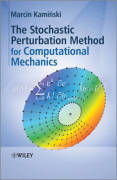|
||
podział tematyczny • wydawnictwa anglojęzyczne podział tematyczny Newsletter: • Zamów informacje o nowościach z wybranego tematu Informacje: • sposoby płatności i dostawy • kontakt • Cookies na stronie • Regulamin zakupów Napisz propresssp@gmail.com |
THE STOCHASTIC PERTURBATION METHOD FOR COMPUTATIONAL MACHANICSKAMINSKI M.wydawnictwo: WILEY , rok wydania 2013, wydanie Icena netto: The Stochastic Perturbation Method for Computational MechanicsProbabilistic analysis is increasing in popularity and importance within engineering and the applied sciences. However, the stochastic perturbation technique is a fairly recent development and therefore remains as yet unknown to many students, researchers and engineers. Fields in which the methodology can be applied are widespread, including various branches of engineering, heat transfer and statistical mechanics, reliability assessment and also financial investments or economical prognosis in analytical and computational contexts. Stochastic Perturbation Method in Applied Sciences and Engineering is devoted to the theoretical aspects and computational implementation of the generalized stochastic perturbation technique. It is based on any order Taylor expansions of random variables and enables for determination of up to fourth order probabilistic moments and characteristics of the physical system response. Key features: * Provides a grounding in the basic elements of statistics and probability and reliability engineering * Describes the Stochastic Finite, Boundary Element and Finite Difference Methods, formulated according to the perturbation method * Demonstrates dual computational implementation of the perturbation method with the use of Direct Differentiation Method and the Response Function Method * Accompanied by a website (www.wiley.com/go/kaminski) with supporting stochastic numerical software * Covers the computational implementation of the homogenization method for periodic composites with random and stochastic material properties * Features case studies, numerical examples and practical applications Stochastic Perturbation Method in Applied Sciences and Engineering is a comprehensive reference for researchers and engineers, and is an ideal introduction to the subject for postgraduate and graduate students. Introduction 3 1. Mathematical considerations 14 1.1. Stochastic perturbation technique basis 14 1.2. Least squares technique description 34 1.3. Time series analysis 47 2. The Stochastic Finite Element Method (SFEM) 73 2.1. Governing equations and variational formulation 73 2.1.1. Linear potential problems 73 2.1.2. Linear elastostatics 75 2.1.3. Nonlinear elasticity problems 78 2.1.4. Variational equations of elastodynamics 79 2.1.5. Transient analysis of the heat transfer 80 2.1.6. Thermo-piezoelectricity governing equations 82 2.1.7. Navier-Stokes equations 86 2.2. Stochastic Finite Element Method equations 89 2.2.1. Linear potential problems 89 2.2.2. Linear elastostatics 91 2.2.3. Nonlinear elasticity problems 94 2.2.4. SFEM in elastodynamics 98 2.2.5. Transient analysis of the heat transfer 101 2.2.6. Coupled thermo-piezoelectrostatics SFEM equations 105 2.2.7. Navier-Stokes perturbation-based equations 107 2.3. Computational illustrations 109 2.3.1. Linear potential problems 109 2.3.1.1. 1D fluid flow with random viscosity 109 2.3.1.2. 2D potential problem by the response function 114 2.3.2. Linear elasticity 118 2.3.2.1. Simple extended bar with random stiffness 118 2.3.2.2. Elastic stability analysis of the steel telecommunication tower 123 2.3.3. Nonlinear elasticity problems 129 2.3.4. Stochastic vibrations of the elastic structures 133 2.3.4.1. Forced vibrations with random parameters for a simple 2 d.o.f. system 133 2.3.4.2. Eigenvibrations of the steel telecommunication tower with random stiffness 138 2.3.5. Transient analysis of the heat transfer 140 2.3.5.1. Heat conduction in the statistically homogeneous rod 140 2.3.5.2. Transient heat transfer analysis by the RFM 145 3. The Stochastic Boundary Element Method (SBEM) 152 3.1. Deterministic formulation of the Boundary Element Method 151 3.2. Stochastic generalized perturbation approach to the BEM 156 3.3. The Response Function Method into the SBEM equations 158 3.4. Computational experiments 162 4. The Stochastic Finite Difference Method (SFDM) 186 4.1. Analysis of the unidirectional problems with Finite Differences 186 4.1.1. Elasticity problems 186 4.1.2. Determination of the critical moment for the thin-walled elastic structures 199 4.1.3. Introduction to the elastodynamics using difference calculus 204 4.1.4. Parabolic differential equations 210 4.2. Analysis of the boundary value problems on 2D grids 214 4.2.1. Poisson equation 214 4.2.2. Deflection of elastic plates in Cartesian coordinates 219 4.2.3. Vibration analysis of the elastic plates 227 5. Homogenization problem 230 5.1. Composite material model 232 5.2. Statement of the problem and basic equations 237 5.3. Computational implementation 244 5.4. Numerical experiments 246 6. Concluding remarks 284 7. References 289 8. Index 300 348 pages, Hardcover Księgarnia nie działa. Nie odpowiadamy na pytania i nie realizujemy zamówien. Do odwolania !. |


